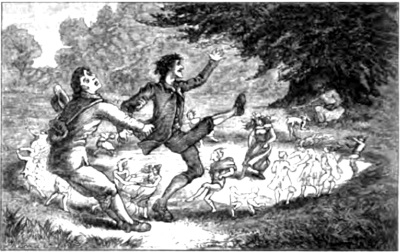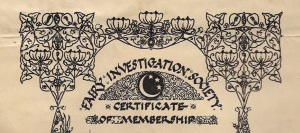Eye Witness Account - Beware the Frenzy of the Fairy Ring - Limerick Residents Wary

In its current newsletter, The Fairy Investigation Society has proffered an eye witness account of a Fairy Ring. The Fairy Investigation Society was founded in 1927 and was active until World War II, lapsed for a period of time and was again active from the 1950s until again falling dormant in the 1990s. The Society, whose membership roll once included Walt Disney and Hugh Dowding, the hero of the Battle of Britain, was comprised of “Fairy Believers” according to the group’s website.
In 2013 the Society was again launched but in a departure from its long history now welcomes anyone with an interest in “Fairy Lore” rather than a belief in Fairies.
From the Investigation Society Newsletter 5, New Series, January 2017
When my mother was a young girl, her father sent her to fetch a bucket of water many fields away from where they lived. On the way back with the water, she stopped at the top of a low lying hill to rest. Looking back down over the fields, she saw a large group of ‘people’ all dancing around in a circle in one of the many local ‘faery forts’ (faery circles). She described their collective dress as comprising of similar colours: red, green and blue. The people were also wearing hats or caps. My mother knew that the area in which she lived at the time of the sighting was sparsely populated, with only a few neighbours close by and those who lived there were not rich or rich enough to have that many people partaking in that type of merriment. Even if they were, it was very early in the day to be doing so and the faery fort was several fields away from the nearest road. It dawned on her that these people were no ordinary people and she could sense that she was not supposed to be looking at this ‘dance’.

She took off running, back to her father’s house, spilling most of the water on the way and in doing so, upon her return, got a ‘good telling off’! She relayed this story to me many years ago only after listening to a local radio station documentary on Irish folklore and legends. A caller phoned in and told a story, which was very similar to hers: a group of people, dancing around in a circle in a faery fort, wearing similarly coloured clothes. This caller’s story would have taken place in the same decade that my mother had hers. My mother kept this story to herself for many decades! I suppose from a combination of ridicule, growing up in Catholic Ireland and the fact that one was to be careful when speaking about ‘the Little People’! The particular faery fort in question still exists and is located behind the Regional Hospital, Dooradoyle, Limerick. Though now, it is completely overgrown with trees and undergrowth. It is mainly used by some of the local people who throw their grass cuttings in over the ditch.
Celtic Mythology's Oral Traditions
Celtic Mythology is rooted in the Oral traditions of the six Celtic nations and in surviving manuscripts. Too few texts have survived the savagery and wanton destruction directed at the Celts over the centuries during the emergence of the modern nation states of England and France. The surviving written Celtic source documents are due to accidents of history and geography, mainly Irish and Welsh in origin. “The Oxford “Dictionary of Celtic Mythology” by Dr. James MacKillop can be considered one of our primary reference texts. The author is a former Professor of English at Syracuse University, former visiting Fellow in Celtic Languages at Harvard University and is past president of the American Conference for Irish Studies.
One of the passages in MacKillop's work is the entry “Fairy Ring” which cautions that you should be wary of where you step:
A circle found in a lawn or pasture land thought to have been caused by dancing fairies. Scientific explanations for this widespread phenomenon are less poetic; the most usual is that it is caused by the spreading mycelia of a fungus. The Fairy Ring may appear only as a depression in the grass but may also include sprouting mushrooms. If a human steps into the ring he or she is compelled to join the fairies in their wild dancing which would seem to occur in a few minutes but in fact lasts for seven years or more. The unfortunate mortal dancer can be rescued by having someone from outside the ring grab hold of his or her coat tails. The concept is widely discussed in the Celtic languages.
Well I’ll tell you what I think. These scientists, they don’t know everything. It isn’t the fungus that makes the ring, it’s the spillage of the fairy juice from their wee cups whilst the little buggers dance. And I’ll tell you something else, that part about the seven years, well I can attest from personal experience that it is true. That’s why I can’t remember much from the age of 28 to 35. For it was when I was 35 that my dear suffering wife yanked me out of that blasted Fairy Ring.
Central Role of Fairies in Celtic Ireland
Brigid Waldron in her May 2013 Transceltic article “Changelings, Fairies, Deities, and Saints: The Integration of Irish Christianity and Fairy Tale Belief” discusses the central role of the Fairy faith in Celtic Ireland:
While the presence of fairies and magic is crucial to many European folk tales, Irish storytelling tradition is especially rooted in the fairy belief, and the varieties of fairy that are presented attest to this. A view of the supernatural was fundamental in Irish folklore, and the fairies that populated these stories were at the heart of that belief. There are three major fairy types in the Irish fairy tale canon—the Sidhe (“Shee”), the Banshee, and the Merrow. Each has its own characteristics that make it unique to Irish folklore. The Sidhe, or the Tuatha De Danaan, were considered a “distinct race, quite separate from human beings, [and] belief in this race of
Content type:
- Irish
Language:
- English
- Log in to post comments






